Why Africa? Changing the Narrative of the World
Interview with Gabriele Del Grande and Dagmawi Yimer
Why Africa? For many years lettera27 has been dedicated to exploring various issues and debates around the African continent and with this new editorial column we would like to open a dialogue with cultural protagonists who deal with Africa. This will be the place to express opinions, tell their stories, stimulate the critical debate and suggest ideas to subvert multiple stereotypes surrounding this immense continent.
With this new column we would like to open new perspectives: geographical, cultural, sociological. We would like the column to be a stimulus to learn, re-think, be inspired and share knowledge. For the opening piece we asked our partners, intellectuals and like-minded cultural protagonists from all over the world to answer one key question, which also happens to be the name of the column: "Why Africa?". We left the question deliberately open, inviting each of the contributors to give us their perspective on this topic from their own context. This first piece is a collection of some of the answers we received, which aims to open the conversation, pose more questions and hopefully find new answers.
Elena Korzhenevich,
lettera27
Here the column's introduction: Why Africa?
Do you believe that cinema can bring about some real change, some shift in the way we look at things, in our perspective? At lettera27, we believe it is possible. We believe in cinema and its power: every film makes us experience a reality that may be different or similar to ours, but through other eyes. We believe in what scholars call “mechanism of identification,” meaning that when we watch a film we feel someone else’s emotions, we put ourselves in someone else’s shoes. We also believe that this effect is not short-lived, but that looking at reality through other people’s eyes can have a positive and lasting effect on how we view our world and live our lives.
This is why we have been supporting one of our partners, the Archive of Migrant Memories (AMM), since its foundation. Together, we believe that documentary film is the ideal language to directly change common perception and encourage critical debate on such a complex and controversial issue as migration. At the Venice Film Festival, where AMM was present to award the Mutti-AMM Prize, we interviewed two extraordinary personalities who have given us a new perspective on migration through their films. We are talking about Gabriele Del Grande, co-director of Io sto con la sposa (On the Bride’s Side), to which lettera27 contributed by helping define the strategy for the crowdfunding campaign, and Dagmawi Yimer, director of Come un uomo sulla terra (Like a Man on Earth), Soltanto il mare (Nothing but the Sea) and Va’ pensiero (Va’ pensiero – Walking Stories), whom we have supported since his filmmaking debut.
This double interview highlights two different, and sometimes conflicting, ways of filmmaking; but it is exactly through their differences that we can grasp the complexity and richness of the modes and codes through which migration stories can be told.
After Venice, both filmmakers have presented their works at many other important venues. Io sto con la sposa participated in international festivals such as the IDFA and Dubai Film Festival, was presented all around Italy through grassroots screenings, and in some cities was a record breaker at the theaters, becoming one of the most successful films of the year. In the meantime, Va' pensiero has just finished a tour across different European cities and has recently turned into an educational kit for schools.
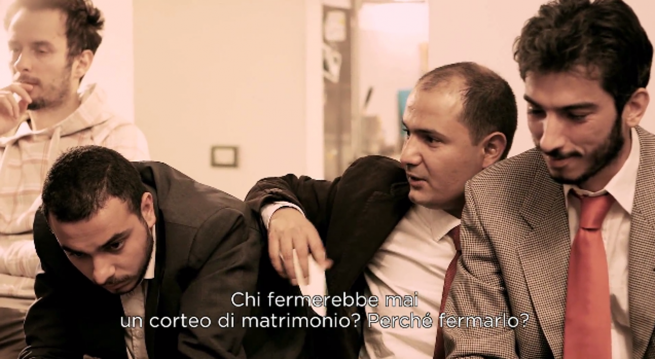
Io sto con la sposa (2014) , screenshot dal film. Courtesy of Antonio Augugliaro, Gabriele Del Grande, Khaled Soliman Al Nassiry
What is the vision behind your work? What kind of change do you think you can bring about with your films on migration?
Dagmawi Yimer: My work has an advantage; it can be seen also by those who have no particular education, because it is about simple facts and common people’s lives. The protagonists of my film are not just victims; they are people whose lives go beyond the facts that have involved them. I try to tell their stories by also describing what happened before and after the attacks. I try to give a body, face and voice to the people who have often remained in the shadow of the events.
Gabriele Del Grande: My work is mainly a matter of storytelling, of narration. Change mainly occurs at the imagination level, in the way we build a narrative of the world. The idea is that, before living in the world, we live in a narrative of the world. Therefore, if we change that narrative, we can bring about some real change. The work that I did in the past and I’m still doing as a journalist, as a writer and now as a filmmaker, is precisely this: I try to tell migration, war and Mediterranean stories in a different way.
We often use the slogan “To overturn the aesthetics of borders”, which means to get rid of whimpering stories where there is always clearly a victim and a game of power played by the interviewer who speaks in the victim’s place and crushes him/her into a victimizing perspective. Overturning the aesthetics therefore means letting the victim speak out – not only by giving him/her back a subjectivity, a name and an image, but turning him/her in some way into a “hero”, capturing the beauty of what happens in certain contexts, even when it seems that there is nothing beautiful in them. Io sto con la sposa makes this attempt; it tells the drama of war and sea crossings, but it does so with a hint of irony, restoring each character’s humanity, which means laughing and crying with them in various situations and partially redefining our sense of “us”. Instead of writing the story of others, we tell the story of “us”, of a more enlarged concept of “us”; we feel part of a wider world, of a common sea, which is our Mediterranean.
In our case, “us” is a group of Italian and Syrian friends who share an adventure. There is also a dreamy element, the imagination of a different world, the attempt to make it real and see how beautiful it is. This is a cultural operation that is contrary to what is usually done with acts of condemnation and all the rhetoric of human rights. I don’t want to say which view is better or worse; our discourse is simply different. We try to conquer our viewers by making a good story rather than pointing a finger and saying “it’s your fault if the world sucks!” It was a choice we made. For example, if we think of Manar, we could have focused on the stories told by a thirteen-year-old boy about the dead in the streets of Damascus; instead, we preferred to film the joy in the eyes of a boy who, after three years of war, eventually holds a concert in Marseille. It is stronger. Beauty touches you more than something you perceive as too far away. I affect you on the basis of something universal; I make you discover a humanity that is there to be found: this person had a dramatic experience, but is a person like you.
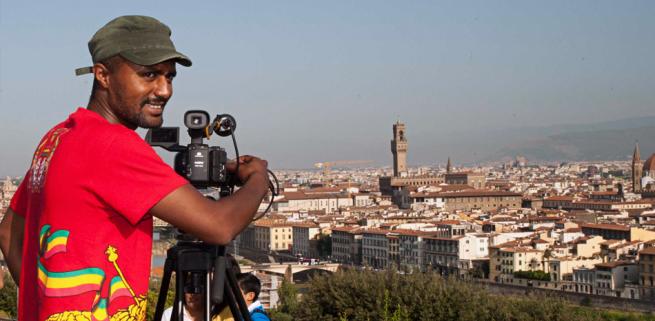 Dagmawi Yimer a Firenze durante le riprese di Và Pensiero. Storie ambulanti (2013). Courtesy of AMM
Dagmawi Yimer a Firenze durante le riprese di Và Pensiero. Storie ambulanti (2013). Courtesy of AMM
Why is cinema the best way to change the symbolic imagery related to migration issues?
G.D.G.: The story of Io sto con la sposa is a little special; we found ourselves involved in it quite accidentally. We didn’t think about the number of people we could reach through a film. It is a fact that the cinematic language is more popular than writing. With a book, if it goes well, you can reach 5,000/10,000 people; with a film, many more. At the same time, making a film is more difficult. With a film, however, you can create a short circuit of images and stereotypes. We put together things that have nothing to do with each other. That’s why everybody remembers this story. For example, what do 40 brides on the Venice red carpet have to do with Lampedusa? We started to play with symbols, and today, for those who know the film, the white veil has become a symbol for the free circulation of people, for some sort of disobedience.
These are things that clash with each other and work precisely for this reason: there is the bride and Lampedusa, the fake wedding and the war in Syria, the baby rapper and the passage to Ventimiglia through the Step of Death. On top of that, there is another element that works at a visual level: seeing a person in suit and tie who tells you about something makes a different impression. You associate Lampedusa with all the rhetoric of despair, the barges… but then you see someone in suit and tie. It is something at odds with our common perception and therefore strikes us most. We didn’t think about it initially, but we realized it only afterwards. We also use quite a pop language. The film looks like fiction; it is not a classic documentary film, if you consider the music, how it was filmed and conceived. This probably helps attract an audience who would hardly approach a documentary film.
D.Y.: As mentioned in a previous interview with Vanessa Lanari, on the one hand I am very happy that migration stories are told, but on the other I am afraid that cinema might amplify existing stereotypes. If you have no direct experience with migration, you have to be more cautious, and give a correct account of other people’s experiences. You cannot tell about migration, you can tell migrants’ stories.
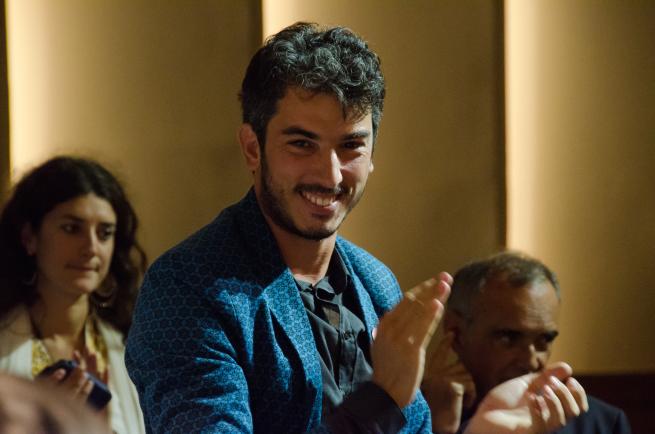 Gabriele Del Grande durante una delle proiezioni di Io sto con la sposa (2014). Photo by Anna Piuzzi
Gabriele Del Grande durante una delle proiezioni di Io sto con la sposa (2014). Photo by Anna Piuzzi
Who are the people you would like to reach with your films?
D.Y.: At the moment, I’m particularly interested in students. The film was presented and screened in many schools all around Italy. Over the last year, two juries composed of students have awarded the film at the Mediterranean Film Festival of Carbonia in Sardinia and the Sole Luna Festival, which is a sign that young people appreciate it.
They mainly react with indignation, for example with regard to the issue of slavery. What struck me most, however, was the fact that students associate Verdi’s Va' Pensiero with the North League Party. So I think that the film makes them discover not only other people’s culture and history, but also part of Italian history.
G.D.G.: We don’t have a specific target. The more people watch it, the better. I’ll tell you a very beautiful thing: in Venice there was a Tunisian friend of ours who came from Tunis just to see the film and liked it a lot, because – he said – “it is one of the few films I’ve ever seen that is able to talk to both the shores of the Mediterranean; it is a story that fits not only here, but also in Tunis.” This is something we really like. This sea of ours, the Mediterranean, has two shores, and we must talk to everybody. This was also possible because it was a mixed group that organized the trip. The power relationship was not linked to the passport: we had Syrians and Palestinians among the organizers, and this created a climate of equal respect for all.
Do you think that sustainable production models such as crowdfunding and co-creation could be replicated in the market? What is your opinion on this theme? How should young filmmakers’ mindset change in order to make documentary films more sustainable?
G.D.G.: In some countries, crowdfunding exists and works. In Italy it is something quite new. We were the first to make such a thing, in the sense that there haven’t been other relevant crowdfunding experiences so far. Can this be a model? In some respects, it surely can. We have addressed a theme that is strongly felt in Italy; there is an audience of thousands of people who are very sensitive to this issue; there is a movement. I don’t want to say it was easy, but there have been a series of favorable circumstances: there was a community around the Fortress Europe blog; we found a clever way to communicate; it was a story that aroused much curiosity; and the press took a strong interest in it because it was a never-heard-before story. So, it surely worked, at least partially (crowdfunding covered part of the costs, but others still need to be met). In general, we might say that it can work, but I wouldn’t say it is the optimal solution.
For example, if crowdfunding had been launched in Italy for The Look of Silence, a very beautiful film we saw in Venice, it wouldn’t have collected a cent. I mean, there are issues that, although important, concern such a small number of people that crowdfunding might not be the best way to fund them. It might be a good weapon, but it is not always usable. However, it is good that it exists, because it has created expectation towards the film, and participation… It turned it into something collective. There are 22,617 people in Italy and Europe who feel part of Io sto con la sposa.
We didn’t think about crowdfunding initially. We thought we could find TV productions or foundations. We knocked at some doors, feeling confident that in a short time we would find the money to complete our work. But then we found ourselves without money, and with the willingness to go on, because we realized it was a good project. At that point, we decided to take our chances and try to raise the funds we needed online with a crowdfunding campaign. We asked a communication agency (Paper Plane Factory) to help us plan the best strategy and we started on May 19. It was another little adventure. What we set in motion in that moment was completely unexpected. When we set the target at 75,000 euros we were not sure of getting there. Then we got to 100,000. The great thing about this film is exactly this: when you talk about a dream, people come together; islands of beauty come together. People want to contribute.
D.Y.: I don’t think that crowdfunding will replace classic production, because it is very difficult to meet the approval of a large number of people. It always depends on your project, but also on the fundraising work, which must be done very seriously. In the case of Gabriele Del Grande, for example, there was a very strong project with a political message as well. This fuels people’s participation. In the case of other films also focusing on different issues, it may be difficult to involve people in a project that still has to be started from scratch. Crowdfunding may be useful for the post-production work, as in the case of Io sto con la sposa, where most of the film had already been shot. It is like when you go to a producer. In the same way, you can present a semi-finished product online and resort to crowdfunding in an intermediate stage of the filmmaking process.
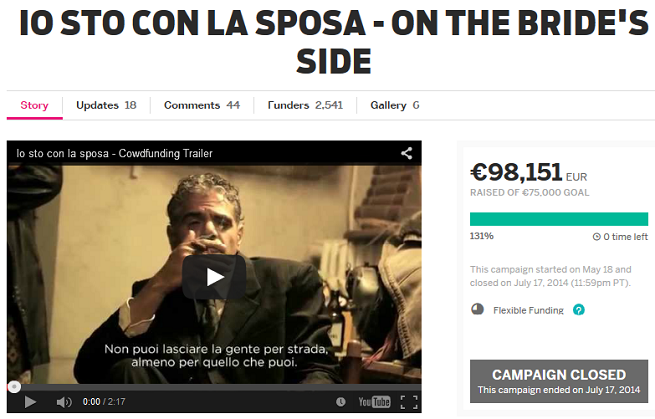
How should institutions’ and producers’ mindset change?
D.Y.: The entire film industry is currently in hardship, especially if we consider films that do not make any profits. We cannot expect much from producers. However, such issues as migration are so important that they cannot be neglected. They must be narrated. Nevertheless, some films are not distributed in the theaters; they fail at the box office, produce no earnings and no return on costs. In my opinion, a possible solution might be the distribution on television networks. If they bought documentary films, this would allow producers to return their costs and invest in other works of the same kind.
What are the most interesting festivals and meeting opportunities for those who produce documentary films raising awareness on civil and social issues?
D.Y.: Some festivals have a very strong bond to the theme of migration. For me they are ‘militant’ festivals, which operate not only in the film industry, but also in civil society. I’m talking about my personal experience, of course. Other festivals have more experts involved both in the film selection and the jury, and many good films in competition, like the Salina Doc Fest. I believe, in general, that festivals are more a training ground for filmmakers than an opportunity for public visibility, and an excellent showcase (with regard to the artistic part). Winning a prize is very important for the curriculum of a filmmaker or a film. But the question remains as to how to bring the film to wider audiences.
What is the role of schools renting docufilms as an educational tool? Are there many of them, or just a few? Can docufilms be a subject of study?
G.D.G.: It is still an idea in development, but we would like to bring the film to the schools. Moreover, we would like to create a kit including a series of texts to be read before seeing the film, with stories of people who have chosen “on which side they wish to stand”, also regardless of the migration discourse. The project for the schools will follow this approach: to choose on which side to stand. The kit will also include some information on the historical context, because not every kid knows what is happening in Lampedusa, Syria or Sweden. After the screening of the film, with the help of teachers and the kit itself, the students will be able to produce some videos or texts based on the theme “on the bride’s side”, but in a more general sense. As a 14-year-old student, you can choose a theme that concerns you and tell us what it means to you to stand on the bride’s side. We would like to put together all these materials on a website’s page, and turn it into an interactive space where we can collect young people’s feedback and in turn stimulate them. I don’t like most of the things usually done at school, where you show a documentary film on the tragedies of the world as if it were the fault of a 16-year-old kid if his/her parents have contributed to the disaster and ruined the world. It is much nicer if I tell you a good story and ask you to think about something good you too can do in your life.
D.Y.: With AMM we created a kit for the schools with great results, and after an intense work involving experts. The kit was presented at the XVIII Meeting of Human Rights at the Mandela Forum for Schools organized by the Tuscany Region in Florence on December 11th, to remember the victims of the 2011 attack on Piazza Dalmazia, one of the events narrated in my film. It will be launched next year by AMM and Giunti Scuola as a pilot project, and will initially be distributed in two regions, Lombardia and Tuscany, with sample surveys in some schools of Rome and Naples.
Each kit is divided into three didactic units and various chapters corresponding to the various themes addressed in the film. For example, colonialism and slavery (which are presented through Mohamed Ba’s show), clichés, stereotypes, and many others. Each section of the film addresses a different topic, so the film can either be seen in full or according to thematic chapters. The kit includes a handbook and is designed to be easily and autonomously used by teachers. There is also the possibility to invite Mohamed Ba or me to present the film to the students. It is an experiment, and we’ll see how it goes, but I’m very confident that, through this, it will be possible to reach all young people who do not often have the possibility to see this kind of films. It is a bet on the future.
Traduzione a cura di Laura Giacalone
With the support of ![]()
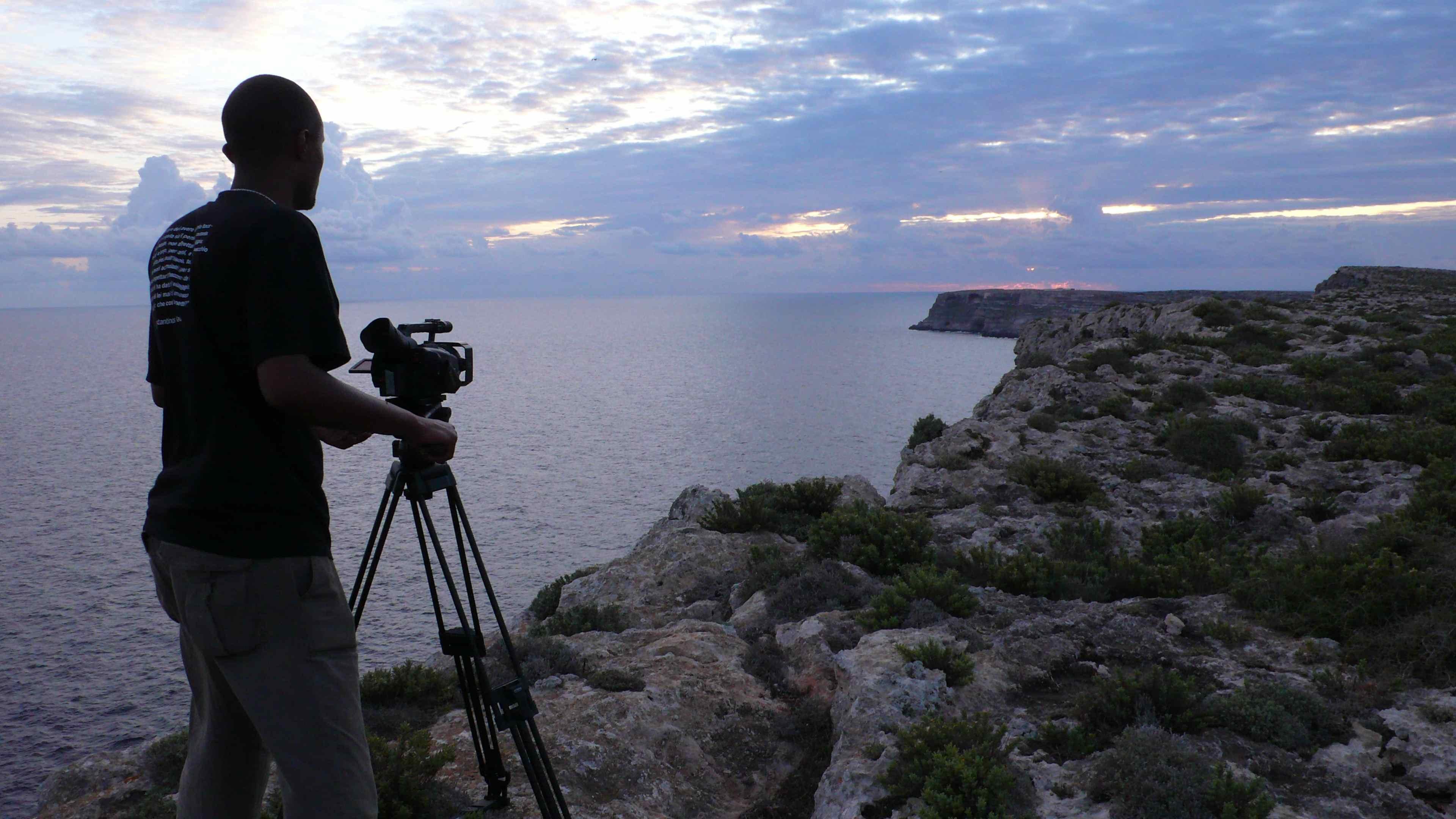









 Since 2011
Since 2011 

